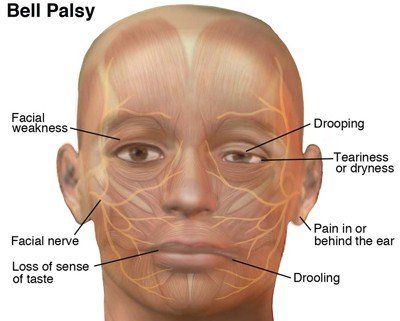Bell’s Palsy Treatment in Bangladesh – Natural Medicine 2023
The best treatment for bell’s palsy in Bangladesh is a combination of medication, physical therapy, and home remedies. Bell’s palsy is a condition that causes temporary paralysis of the facial muscles, usually on one side of the face.
It can be a distressing condition, but with the right treatment, most people recover fully within a few months. Medications, such as corticosteroids, are commonly prescribed to reduce inflammation and promote healing. Physical therapy exercises, such as facial massages and stretching, can help improve muscle strength and mobility.
Additionally, home remedies like warm compresses and relaxation techniques may provide relief. It is important to consult with a healthcare professional to determine the best treatment plan for individual needs.

Credit: www.myactionpt.com
The Basics Of Bell’S Palsy
Bell’s palsy is a condition that affects facial muscles, causing weakness or paralysis on one side of the face. The best treatment options for bell’s palsy include medication, physiotherapy, and lifestyle changes to help manage the symptoms and promote recovery.
Understanding The Condition And Its Symptoms
Bell’s palsy is a condition that affects the facial muscles, causing weakness or paralysis on one side of the face. It occurs when the facial nerve, which controls these muscles, becomes inflamed or compressed. This condition can be quite distressing and can impact a person’s ability to smile, blink, or perform other facial movements.
The symptoms of bell’s palsy typically come on suddenly and reach their peak within 48 hours. Common signs and symptoms include:
- Facial drooping on one side
- Difficulty closing one eye or blinking
- Pain or discomfort around the jaw or behind the ear on the affected side
- Increased sensitivity to sound in one ear
- Changes in taste
- Difficulty speaking or eating
- Dryness or excessive tearing in one eye
The severity of bell’s palsy symptoms can vary from person to person. Some individuals may only experience mild weakness, while others may have complete paralysis on the affected side of their face. It’s essential to seek medical attention if you notice any of these symptoms, as early treatment can improve recovery outcomes.
Causes And Risk Factors Of Bell’S Palsy
The exact cause of bell’s palsy is still unknown. However, it is believed to occur due to swelling and inflammation of the facial nerve, which can be triggered by various factors. Some common causes and risk factors of bell’s palsy include:
- Viral infections: Bell’s palsy is often associated with viral infections, particularly the herpes simplex virus (hsv), which causes cold sores. Other viral infections, such as the flu or respiratory tract infections, have also been linked to the development of bell’s palsy.
- Immune system dysfunction: An abnormal immune response may lead to inflammation and nerve damage, increasing the risk of bell’s palsy.
- Family history: Individuals with a family history of bell’s palsy may be more susceptible to developing the condition themselves.
- Pregnancy: Pregnant women, especially during the third trimester, have a slightly higher risk of developing bell’s palsy.
- Diabetes: People with diabetes have an increased likelihood of experiencing nerve damage, including the facial nerve, which may increase the risk of developing bell’s palsy.
- Age and gender: Bell’s palsy can occur at any age, but it is more common in individuals aged 15 to 60 years. Additionally, it affects both men and women equally.
While these factors may contribute to the development of bell’s palsy, it’s important to note that the condition can affect anyone, regardless of their overall health or lifestyle. If you suspect you have bell’s palsy, it’s crucial to consult with a healthcare professional for an accurate diagnosis and appropriate treatment.
Diagnosing Bell’S Palsy in Bangladesh
Bell’s palsy can be diagnosed through a series of tests, such as physical exams and imaging scans, to determine the underlying cause. Early diagnosis is crucial for the best bell’s palsy treatment options, which may include medications, physiotherapy, and lifestyle changes.
Seeking prompt medical attention is essential for effective management of the condition.
Identifying The Signs And Symptoms
Bell’s palsy is a condition that affects the facial muscles, causing temporary weakness or paralysis on one side of the face. Recognizing the signs and symptoms is crucial for an accurate diagnosis. Here are some key indicators:
- Sudden onset of facial weakness or drooping, typically on one side of the face
- Difficulty closing one eye or blinking
- Decreased or loss of sense of taste on the front two-thirds of the tongue
- Increased sensitivity to sound in one ear
- Pain or discomfort around the jaw or behind the ear on the affected side
- Drooling or a drooping mouth
- Changes in the ability to speak clearly or difficulties with facial expressions
- Dryness or excessive tearing in one eye
Medical Tests And Examinations For Diagnosis
When it comes to diagnosing bell’s palsy, medical professionals rely on a combination of physical examinations and tests to rule out other possible causes. Here are the common approaches used for diagnosis:
- Physical examination: A healthcare provider will assess the facial muscles, eyelids, and sense of taste. They may also test your ability to close your eyes, raise your eyebrows, smile, or show your teeth.
- Medical history review: Your doctor will ask questions about your symptoms, how they started, and any other relevant medical conditions or events. Providing a detailed history will help determine the cause and suitable treatment options.
- Blood tests: Although there is no specific diagnostic blood test for bell’s palsy, certain blood tests can help rule out other potential causes, such as infections or autoimmune disorders.
- Imaging tests: Sometimes, diagnostic imaging tests like magnetic resonance imaging (mri) or computed tomography (ct) scans may be recommended to exclude other conditions like tumors or nerve damage.
- Electromyography (emg): This test measures electrical activity in the muscles, helping evaluate the extent of nerve damage and differentiate between bell’s palsy and other conditions affecting facial nerves.
- Nerve conduction studies: By stimulating the facial nerves and recording their responses, nerve conduction studies can help identify any abnormalities and assess the severity of nerve damage.
Remember, these tests and examinations are carried out by healthcare professionals who can provide an accurate diagnosis. If you experience any signs or symptoms of bell’s palsy, consult a medical expert promptly to receive appropriate care and treatment.
Conventional Treatment Options
The best bell’s palsy treatment options encompass a range of conventional approaches that target the underlying cause of this condition. These options may include medications, physical therapy, and lifestyle modifications to alleviate symptoms and facilitate recovery.
Bell’s palsy is a condition that can cause temporary paralysis or weakness of the muscles on one side of the face. While the exact cause is still unknown, there are several conventional treatment options available to help manage the symptoms and promote recovery.
These treatment options include:
Medications Prescribed For Bell’S Palsy:
- Corticosteroids: These anti-inflammatory drugs, such as prednisone, are commonly prescribed to reduce inflammation and swelling in the facial nerves. They can help speed up recovery and minimize the severity of symptoms.
- Antiviral medications: Since viral infections, particularly the herpes simplex virus, are often associated with bell’s palsy, antiviral drugs like acyclovir may be prescribed to target the underlying viral cause.
- Pain medications: Over-the-counter pain relievers, such as ibuprofen or acetaminophen, can help alleviate any discomfort or pain experienced during the course of bell’s palsy.
Physical Therapy Techniques For Speedy Recovery:
- Facial exercises: Specific exercises that target the affected facial muscles can help improve muscle strength, prevent muscle loss, and restore normal movement of the face. These exercises may include blowing out the cheeks, raising the eyebrows, or smiling symmetrically.
- Massage therapy: Gentle massage techniques, performed by a trained therapist, can aid in improving circulation, reducing muscle tension, and promoting overall relaxation of the facial muscles. This can contribute to a more speedy recovery from bell’s palsy.
- Moist heat application: Applying warm compresses or using a warm towel on the affected side of the face can help relieve pain, reduce inflammation, and promote blood flow to aid in the healing process.
Surgical Interventions For Severe Cases:
In severe cases of bell’s palsy, where the paralysis and muscle weakness persist over an extended period or do not show signs of improvement, surgical interventions may be considered. These surgical procedures aim to relieve pressure on the facial nerves or repair any damage to the nerves.
Some surgical options include:
- Facial nerve decompression: This surgical procedure involves relieving pressure on the facial nerve by removing a small section of bone or tissue to create more space for the nerve to function properly.
- Nerve grafting: In cases where there is significant nerve damage, a nerve graft may be used to replace the damaged or missing section of the facial nerve. This can help restore muscle movement and improve facial symmetry.
- Muscle transfer: In certain severe cases, a muscle transfer procedure may be performed. This involves taking a healthy muscle from another part of the body, typically from the thigh or forearm, and surgically attaching it to the affected side of the face to restore muscle movement.
While conventional treatment options can be effective in managing bell’s palsy, it is important to consult with a healthcare professional to determine the most appropriate treatment plan based on individual circumstances. These treatment options, including medications, physical therapy techniques, and surgical interventions, aim to promote a faster recovery, alleviate symptoms, and enhance overall quality of life for individuals affected by bell’s palsy.
Natural Remedies For Bell’S Palsy
Discover effective natural remedies for bell’s palsy, the best treatment options that can provide relief and promote recovery. Explore safe and accessible alternatives without harmful side effects.
Experiencing bell’s palsy can be unsettling, but there are natural remedies that can help alleviate its symptoms and promote healing. These remedies include herbal supplements, lifestyle changes, and alternative therapies. Let’s explore each of these in detail:
Herbal Supplements And Their Effectiveness
Using herbal supplements can be an effective way to manage bell’s palsy symptoms. Here are some supplements that have shown promise in reducing inflammation and improving nerve function:
- Turmeric: Curcumin, the active compound in turmeric, has powerful anti-inflammatory properties that can help reduce facial paralysis caused by bell’s palsy.
- B-vitamins: Supplements like b12 and b6 can support nerve health and aid in nerve regeneration, providing relief from facial weakness and pain.
- Omega-3 fatty acids: Found in fish oil, omega-3 fatty acids possess anti-inflammatory properties that may help reduce the severity of bell’s palsy symptoms.
It’s important to consult with a healthcare professional before starting any herbal supplement regimen to ensure safety and effectiveness.
Lifestyle Changes For Symptom Relief
Making certain lifestyle changes can complement the treatment of bell’s palsy and provide relief from its symptoms. Consider the following lifestyle adjustments:
- Stress management: Practicing stress-reducing techniques like meditation, deep breathing exercises, or yoga can help alleviate emotional distress and potentially improve facial muscle control.
- Facial exercises: Engaging in gentle facial exercises, such as smiling, raising the eyebrows, or blowing kisses, can help improve muscle tone and flexibility, promoting faster recovery.
- Heat therapy: Applying warm compresses or using a heating pad on the affected side of the face can help relieve pain and encourage blood circulation, aiding in the healing process.
Alternative Therapies For Holistic Healing
In addition to herbal supplements and lifestyle changes, alternative therapies can provide holistic healing and relief from bell’s palsy symptoms. Consider the following options:
- Acupuncture: This traditional chinese medicine practice involves the insertion of fine needles into specific points on the body to stimulate energy flow, potentially reducing facial paralysis and improving nerve function.
- Physical therapy: Working with a physical therapist who specializes in facial exercises and rehabilitation techniques can help improve muscle control, reduce pain, and promote faster recovery.
- Massage therapy: Gentle facial massages can help improve blood circulation, relax tense muscles, and alleviate facial pain associated with bell’s palsy.
While natural remedies can be beneficial, it’s crucial to consult with a healthcare professional or a qualified practitioner before trying any alternative therapies to ensure they are safe and suitable for your specific condition.
Remember, these natural remedies are intended to complement medical treatment and should not replace professional medical advice. Consistency and patience are key as natural remedies may take some time to show noticeable results. Be sure to follow the guidance of your healthcare provider throughout the treatment process for the best outcome.
Managing Bell’S Palsy At Home
Manage bell’s palsy at home with the best treatment options available. Learn effective ways to alleviate symptoms and promote recovery naturally.
Self-Care Tips For Managing Symptoms
- Apply warm compresses to the affected side of the face for 10-15 minutes, several times a day, to help reduce pain and inflammation.
- Practice good facial hygiene by gently washing the face with a mild cleanser and moisturizing regularly to prevent dryness and discomfort.
- Avoid extreme temperatures, as exposure to cold or hot weather can worsen bell’s palsy symptoms. Protect the affected side of the face with a scarf or hat during colder months.
- Take over-the-counter pain relievers, such as ibuprofen or acetaminophen, as directed by your healthcare provider to manage any facial pain associated with bell’s palsy.
- Get plenty of rest and sleep to allow your body to heal and recover. Avoid stress and practice relaxation techniques like deep breathing or meditation to help reduce muscle tension.
Facial Exercises And Massage Techniques
- Perform gentle facial exercises to help strengthen facial muscles and improve mobility. Smile widely, raise your eyebrows, puff out your cheeks, and close your eyes tightly to engage the affected muscles.
- Massage the affected side of the face using gentle circular motions with your fingertips. This can help promote blood circulation and relieve muscle stiffness.
- Use facial massage techniques to stimulate the nerves and encourage muscle movement. Start by applying gentle pressure to the forehead, cheeks, and jawline, then gradually increase the pressure as tolerated.
Protective Measures For Eye Care
- Protect your affected eye from dryness and irritation by using artificial tears or lubricating eye drops regularly throughout the day.
- Use an eye patch or tape to keep your affected eye closed during sleep to prevent corneal abrasion and aid in recovery.
- Avoid wearing contact lenses until the symptoms of bell’s palsy subside to prevent further eye irritation.
- Consult an eye care professional if you experience persistent eye dryness, redness, or vision changes.
Remember, managing bell’s palsy at home involves self-care practices, facial exercises, and protective measures for eye care. By incorporating these tips into your daily routine, you can help alleviate symptoms and promote healing. It is important to consult with your healthcare provider for personalized advice and guidance throughout your bell’s palsy treatment journey.
Diet And Nutrition For Bell’S Palsy Recovery
Discover how diet and nutrition can aid in the recovery of bell’s palsy, offering the best treatment for this condition. Improve your chances of healing by focusing on a well-balanced diet that includes essential vitamins, minerals, and antioxidants to promote nerve regeneration and overall health.
A healthy diet plays a crucial role in promoting recovery from bell’s palsy. By focusing on nutrient-rich foods and avoiding certain substances, you can support nerve regeneration and optimize the healing process. Here are some dietary recommendations to consider during your recovery:
Foods To Avoid During The Recovery Phase:
- Processed foods: Stay away from processed foods that are often high in unhealthy fats, sodium, and preservatives. These can hinder the body’s healing mechanisms.
- Sugary treats: Limit your intake of sugary snacks, desserts, and beverages. Excessive sugar consumption can lead to inflammation and compromise your immune system.
- Caffeinated drinks: Minimize your consumption of caffeinated beverages, such as coffee and energy drinks. Caffeine can have detrimental effects on the nervous system.
- Alcohol: It’s best to avoid alcohol during the recovery phase as it can interfere with your body’s healing processes.
- High-sodium foods: Reduce your sodium intake by avoiding heavily salted foods. Excessive sodium can contribute to fluid retention and elevate blood pressure.
Nutritional Recommendations For Nerve Regeneration:
- Omega-3 fatty acids: Incorporate foods rich in omega-3 fatty acids, such as salmon, walnuts, and flaxseeds, into your diet. These healthy fats have anti-inflammatory properties and can aid in nerve repair.
- Antioxidant-rich foods: Consume plenty of fruits and vegetables that are packed with antioxidants. Blueberries, kale, spinach, and bell peppers are excellent choices as they can help combat oxidative stress and promote healing.
- Protein sources: Include lean sources of protein, like chicken, fish, tofu, and beans, in your meals. Protein is vital for tissue repair and regeneration.
- Whole grains: Opt for whole grains such as quinoa, brown rice, and whole wheat bread. These provide essential nutrients and fiber, promoting overall health and well-being.
- Hydration: Drink an adequate amount of water each day to keep your body hydrated. Staying hydrated aids in nutrient absorption and supports cellular functions.
Essential Vitamins And Minerals For Healing:
- Vitamin b12: Include foods rich in vitamin b12, like eggs, dairy products, and fortified cereals. This vitamin is important for nerve health and function.
- Vitamin c: Consume citrus fruits, strawberries, bell peppers, and broccoli to obtain ample amounts of vitamin c. this powerful antioxidant aids in collagen production, promoting healing and strengthening of nerves.
- Vitamin e: Incorporate vitamin e-rich foods, such as almonds, spinach, and sunflower seeds, into your diet. Vitamin e helps protect nerve cells from damage and aids in their repair.
- Magnesium: Ensure an adequate intake of magnesium by including foods like nuts, seeds, legumes, and leafy greens in your meals. Magnesium is essential for nerve function and can support the recovery process.
- Zinc: Consume foods high in zinc, such as oysters, beef, pumpkin seeds, and spinach. Zinc plays a crucial role in nerve development and repair.
Remember, while diet and nutrition can support your recovery from bell’s palsy, it is essential to consult with a healthcare professional or a registered dietitian to design an individualized approach that meets your specific needs.
Psychological Support And Coping Strategies
Psychological support and coping strategies play a crucial role in the best bell’s palsy treatment in Bangladesh. These interventions help individuals manage the emotional and psychological impact of the condition, supporting their overall well-being and recovery process.
Dealing With Emotional Distress Associated With Bell’S Palsy
Bell’s palsy can have a significant impact on a person’s emotional well-being, causing feelings of distress and affecting their self-esteem. It is essential for individuals with bell’s palsy to have proper psychological support and develop coping strategies to manage the emotional challenges they may face.
Here are some helpful approaches:
- Seek emotional support from friends and family: Talking to loved ones about your feelings can provide a sense of understanding and comfort. They can offer encouragement and be a source of strength during difficult times.
- Consult with mental health professionals: Therapists or counselors specialized in dealing with health-related issues can provide valuable guidance and support. They can help you explore your emotions, develop coping mechanisms, and offer strategies to manage stress and anxiety.
- Join a support group: Connecting with others who are experiencing or have overcome bell’s palsy can be immensely beneficial. Support groups offer a safe space to share experiences, exchange advice, and provide emotional support.
- Practice mindfulness and relaxation techniques: Mindfulness exercises, such as deep breathing and meditation, can help reduce stress and promote a sense of calmness. Engaging in activities like yoga or tai chi can also aid in relaxation and stress reduction.
- Maintain a positive mindset: Focusing on positive thoughts and affirmations can help uplift your spirits and improve your overall well-being. Surround yourself with uplifting and supportive people, engage in activities you enjoy, and practice self-care.
Support Groups And Counseling Options
Finding support from others who have experienced the challenges of bell’s palsy can make a significant difference in a person’s journey towards recovery. Support groups and counseling options provide a platform for individuals to connect, share their experiences, and gain support.
Here are some options to consider:
- Local support groups: Check with your healthcare provider, community centers, or hospitals for information on local support groups specifically for bell’s palsy. These groups usually meet regularly and offer an opportunity to connect with others facing similar challenges.
- Online support communities: With the advent of the internet, online support communities have become a valuable resource for individuals seeking support and information. Joining online forums or social media groups dedicated to bell’s palsy can provide a sense of community, where you can connect with others anytime, from anywhere.
- Individual counseling: If you feel the need for one-on-one support, consider consulting with a mental health professional experienced in addressing the emotional impact of bell’s palsy. They can provide personalized guidance, coping strategies, and help you navigate any emotional challenges you may be facing.
Remember, seeking support is not a sign of weakness but a courageous step towards emotional healing and well-being.
Mindfulness And Relaxation Techniques For Stress Reduction
Stress and anxiety are common reactions to bell’s palsy, and they can contribute to the overall discomfort experienced during its course. Incorporating mindfulness and relaxation techniques into your daily routine can help reduce stress levels. Here are some techniques to consider:
- Deep breathing exercises: Take deep breaths in through your nose, allowing your belly to expand, and exhale slowly through your mouth. Focusing on your breath can help calm your mind and relax your body.
- Progressive muscle relaxation: Start by tensing and then relaxing each muscle group in your body, from your toes to your head. This technique helps release tension and promotes relaxation.
- Guided meditation: Listen to guided meditation recordings or use meditation apps that provide calming and soothing narratives to help you relax and focus your mind.
- Engage in hobbies and activities you enjoy: Finding joy in activities that bring you happiness and help you unwind can be an excellent way to reduce stress. Whether it’s painting, reading, listening to music, or going for a walk in nature, make time for activities that nourish your soul.
By incorporating these mindfulness and relaxation techniques into your routine, you can effectively manage stress, promote emotional well-being, and support your overall recovery journey.
Prevention And Long-Term Management
Prevention and long-term management play a crucial role in the best bell’s palsy treatment in Bangladesh. By implementing preventive measures and adopting effective strategies for managing the condition, individuals can improve their overall well-being and minimize the impact of bell’s palsy on their daily lives.
Bell’s palsy is a condition that affects the facial muscles, leading to temporary paralysis or weakness on one side of the face. While there is no definitive cure for bell’s palsy, there are several measures that can be taken to prevent recurrent episodes and manage the condition in the long term.
In this section, we will explore these preventive strategies and long-term management techniques in detail.
Preventing Recurrent Episodes Of Bell’S Palsy:
- Reduce stress levels: Engaging in stress management techniques such as meditation, deep breathing exercises, or yoga can help minimize the chances of experiencing recurrent episodes of bell’s palsy.
- Maintain a healthy lifestyle: Regular exercise, a balanced diet, and sufficient sleep are all important factors in boosting the immune system and reducing the risk of bell’s palsy recurrence.
- Protect your facial nerves: During cold and windy weather, wearing a scarf or using a hat can shield your face from external factors that may trigger bell’s palsy.
- Adequate rest and self-care: Getting enough rest and taking care of yourself when feeling fatigued or rundown can contribute to preventing further episodes of bell’s palsy.
Long-Term Strategies For Facial Muscle Strength:
- Physical therapy exercises: Performing facial exercises recommended by a healthcare professional can help improve muscle strength and control in the affected area. These exercises may include smiling, frowning, and puffing out the cheeks.
- Massage therapy: Gently massaging the affected side of the face with circular motions can help stimulate blood flow and promote muscle strength.
- Acupuncture: Some individuals find acupuncture beneficial for improving facial muscle strength and reducing the severity of bell’s palsy symptoms.
- Facial electrical stimulation: This technique involves the application of low-level electrical currents to the facial muscles, which can aid in muscle re-education and strengthening.
Managing Potential Complications Of Bell’S Palsy:
- Eye care: As bell’s palsy can affect the eye’s ability to close properly, it is important to keep the eye moist and protected. Utilizing eye drops, wearing eye patches at night, or using protective glasses can prevent eye dryness and potential injuries.
- Speech and swallowing therapy: In some cases, bell’s palsy may affect speech and swallowing abilities. Undergoing therapy with speech and swallowing specialists can assist in the recovery of these functions.
- Emotional support: Bell’s palsy can have an impact on an individual’s emotional well-being. Seeking support from loved ones, joining support groups, or considering counseling services can help manage the emotional challenges that may arise.
By adopting preventive measures, focusing on long-term muscle strength, and managing potential complications, individuals with bell’s palsy can take proactive steps towards a better quality of life. It is essential to consult with healthcare professionals to develop a personalized treatment plan tailored to an individual’s specific needs.
Remember, early detection and intervention play a crucial role in minimizing the impact of bell’s palsy and maximizing recovery potential.
Frequently Asked Questions On Best Bell’S Palsy Treatment
What Are The Common Symptoms Of Bell’S Palsy?
Bell’s palsy typically causes sudden weakness or paralysis on one side of the face. Other symptoms may include facial drooping, difficulty closing one eye, loss of sense of taste, and pain around the jaw or behind the ear. It is important to seek medical attention if you experience these symptoms.
How Is Bell’S Palsy Diagnosed?
Doctors diagnose bell’s palsy based on your symptoms and a physical examination. They may also conduct tests to rule out other possible causes of facial paralysis, such as blood tests, imaging tests, or electrical tests of nerve function. It is important to consult a healthcare professional for an accurate diagnosis.
What Is The Best Treatment For Bell’S Palsy?
The best treatment for bell’s palsy may vary depending on the individual and the severity of the condition. Options may include medications such as corticosteroids to reduce inflammation, physical therapy exercises for the facial muscles, and eye care techniques to prevent dryness and protect the eye.
It is important to consult with a healthcare professional to determine the most suitable treatment plan.
Can Bell’S Palsy Be Cured Completely?
In most cases, bell’s palsy resolves on its own within three to six months, with complete recovery. However, some individuals may continue to experience mild weakness or other residual effects. Early treatment and appropriate care can help improve the chances of full recovery.
It is important to follow your healthcare professional’s advice for the best possible outcome.
What Are The Risk Factors For Developing Bell’S Palsy?
The exact cause of bell’s palsy is still unknown, but certain factors may increase the risk of developing the condition. These include having a viral infection such as the common cold or flu, being pregnant, having a family history of bell’s palsy, and having a history of respiratory or ear infections.
It is important to be aware of these risk factors and seek prompt medical attention if symptoms occur.
Can Bell’S Palsy Affect Both Sides Of The Face?
Although rare, bell’s palsy can affect both sides of the face simultaneously or at different times. This condition is known as bilateral bell’s palsy. It is important to consult a healthcare professional for proper diagnosis and treatment if you experience symptoms on both sides of your face.
Conclusion
Finding the best treatment for bell’s palsy is essential for individuals seeking relief from the symptoms of this condition. From understanding the causes and symptoms to exploring a range of treatment options, it’s clear that there are effective approaches available.
Physical therapy, including exercises to strengthen facial muscles and improve coordination, can be particularly beneficial. Additionally, medications like corticosteroids can help reduce inflammation and promote healing. In some cases, complementary therapies such as acupuncture or electrical stimulation may also be worth considering.
Ultimately, the best treatment approach will depend on individual circumstances and should be discussed with a healthcare professional. By being proactive and exploring different treatment options, individuals with bell’s palsy can improve their chances of recovery and enhance their overall quality of life.

Dr. Helal, uniting science and nature for holistic health. Pioneering natural medicine for balanced living.








